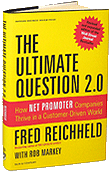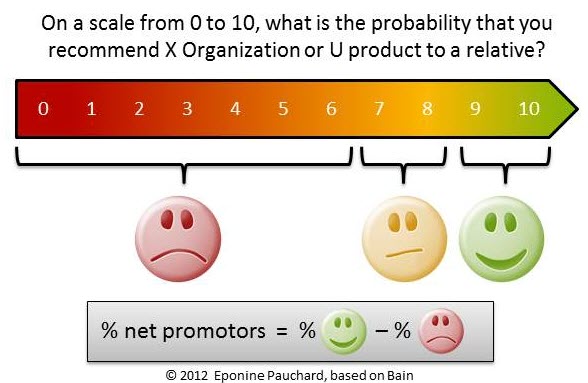
I recently read The Ultimate Question 2.0: How Net Promoter Companies Thrive in a Customer-Driven World by Fred Reichheld. The ultimate question is an interesting concept that fits well into the lean toolkit. I propose a series of four articles to explore this concept. In this first article, I explain what this ultimate question is and how to calculate the net promoter score.
Why is this the ultimate question?
The ultimate question was presented by Fred Reichheld in 2003. It should be noted that the brand Net Promoter ® is filed by Fred Reichman, Bain and Company and Satmetrix; respectively the inventor, the consulting firm and the statistical data provider.
The ultimate question provides the net promoter score (NPS). According to Fred Reichheld, this indicator is very strongly correlated to the future growth of the company, which explains the need to focus on and improve it. According to him, the satisfaction surveys are long and bring little results: rare are the customers who fill them, due to lack of time. His unique question approach improves the response rate. With a greater number of respondents, statistical reliability improves.
So let’s get started, with the ultimate question:
On a scale of 0 to 10, how likely are you to recommend our product / company to a relative?
The question is very simple. According to the companies, the scale will vary from 1 to 10 or from 1 to 5. This is not the most important.
The concept is in the breakdown of respondents. They are separated into three categories. Those who gave a score of 9 or 10 are the promoters, 7 or 8 are the passives and those who put 6 or less are the detractors. The net promoter score is calculated by removing the percentage of detractors from the percentage of promoters. It can range from -100% (detractors only) to 100% (only promoters). A score is considered good starting at 50%, there are of course important variations according to the sectors.

What are promoters and detractors?
A promoter is a person who can recommend the company to his relatives. You know, like me, that you do not recommend anything to your loved ones. When someone asks you: do you know a good hairdresser? You will name the one who has provided you with exceptional service. If you have moderately appreciated your experience, you will not give their name. According to Reichheld‘s studies, promoters, beyond the recommendation to their friends, will mainly buy more and longer with the company: they are loyal and generate more financial benefits. They also use less customer service and are more pleasant and understanding when it happens. All these positive effects on the sales volume and teams engagement turn them into desired customers.
On the contrary, the detractors had a bad experience, and tell their friends, I do not know a good hairdresser, but do not go to this one. You have lost their trust, they make you bad publicity, and as they are often angry, they can be expensive in lawsuit (remember that Fred Reichheld is American).

This way of classifying customers is a way of emphasizing their experience. Which is one of the principles of lean: to satisfy its customers.
With a feedback based on a single question, we preserve the precious time of our customers, while having clear information. The calculation of this indicator is simple. I will come back in my next article on how the indicator can be exploited.
